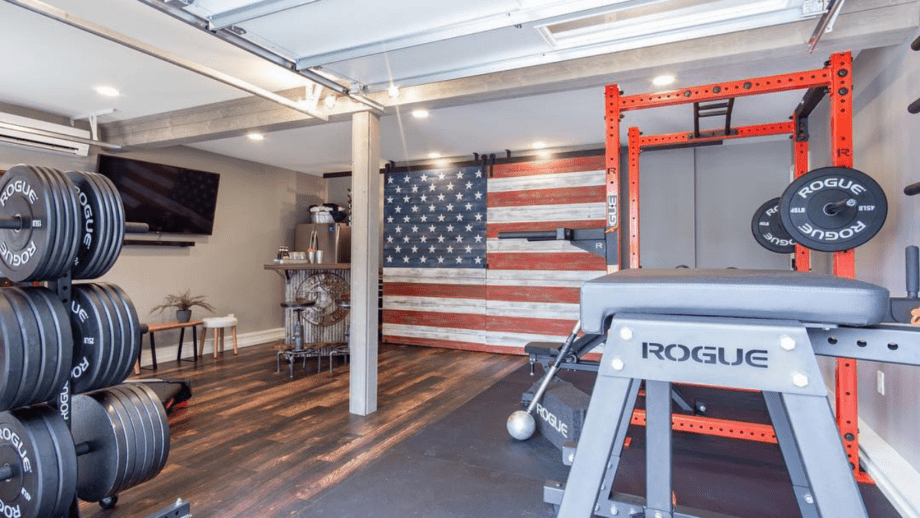We test and review fitness products based on an independent, multi-point methodology. If you use our links to purchase something, we may earn a commission. Read our disclosures.
So you want to build a gym at home, and you’re wondering, “How much does a home gym cost?”. You’re not alone; this is by far one of the most asked questions we receive. We’ve detailed just how much you can expect to spend and believe it’s likely much less than you think. A home gym can not only be built on a budget, but it can also be an extremely smart financial decision.
As with any hobby, a home gym can be extremely costly to start, however, it doesn’t have to be. In fact, you can start a home gym with as little money as you have or even nothing but the things you have lying around the house. We want to bust the myth that a home gym is only for the wealthy and well to do. A home gym, if used properly, has the power to benefit everyone physically, mentally, and fiscally. We’ve seen people drive down debt, increase energy, and decrease body fat through the building of a gym in their home or garage. Join the community and you too can reap the benefits.
Why You Should Build a Home Gym
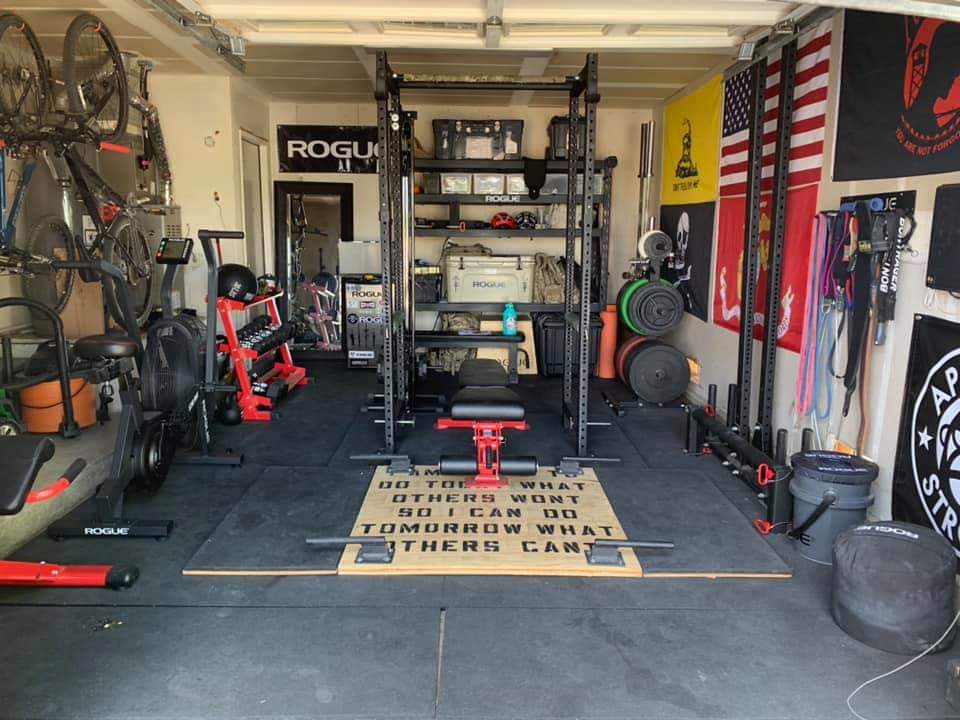
Have you ever wondered why everyone in your life with a home gym is constantly telling you how great it is? I was that way. Before I started my garage gym, I worked out at a CrossFit gym, paying nearly $200 a month for both my wife and I to workout at a gym that we certainly enjoyed, and we did recognize that there were more affordable commercial gym options, but we still saw many areas for improvement. I noticed that although our monthly membership fee was around $200, we were spending much more when the gas, car maintenance, and time were factored in. Throw in the fact that the gym wasn’t super close, and it began to seem pretty frivolous to be spending so much to use someone else’s barbells and plates (especially considering how low quality the equipment was.)There are a few things that nearly everyone reading this could benefit from and I certainly could then when I was a slave to the monthly gym membership. These are:
- More Time
- More Money
- More Health

Time is our most finite resource. You may feel like you have a very long life ahead of you (and I hope you do,) but the reality is, time is ticking away and we aren’t guaranteed our next breath. I want to maximize my time here on Earth as much as possible and I believe others do as well. Not only that, but when you factor in the cost of your time, your time spending habits may change. For instance, how much is your wage if you were to break it down hourly? Now, consider that time that could be spent making money (or running errands, pursuing a hobby, building a business, hanging with family, learning something new, etc) is now spent on your commute to the gym.
This illustration of time doesn’t even factor in the amount of time it takes to get your workout done at the gym. A majority of commercial gyms are lacking in the most important piece of equipment in a gym for most people’s goals, namely squat racks. So, that time spent on the sidelines waiting for Mr. Superset Everything to complete his ¼ squats and barbell curls (done conveniently in the squat rack of course) could be spent much more productively should you not have to wait to workout. Every decision has a seemingly infinite amount of choices not chosen. Essentially, by saying I’m going to drive to the gym, pay for the gym, take a long time to use the gym, and drive home from the gym, is you saying “no” to an insane amount of things that would probably be better for you to say “yes” to, like more money.
A home gym, although a cost, can, in fact, be a very frugal cost and money-saver if done properly. Think about this, the difference between a home gym and a commercial gym in terms of money spent is very similar to the difference in buying a car and leasing a car. When you buy a car outright, you own that car. You can do whatever you want with it and it’s yours. If you lease a car, you pay a fee to use somebody else’s car. Leasing, also known as “fleecing” by various financial experts (I’m a former financial planner so I’ve spent a lot of time with these concepts) is a much more expensive way to drive a car.
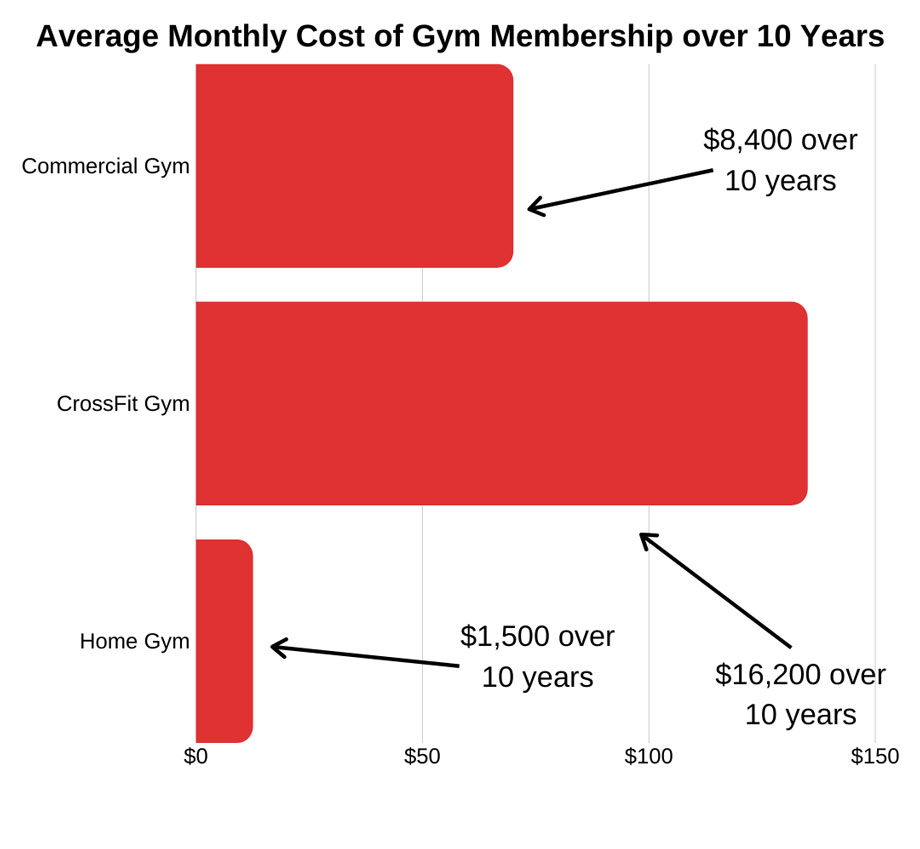
A home gym, like buying a car outright, is now yours to keep forever. However, a home gym doesn’t depreciate as quickly as a car (if bought following our suggestions,) and never has to be upgraded unless you simply want to. You can literally keep your best home gym equipment until you pass away and give it to your children or your children’s children. Powder-coated steel lasts that long and unlike technology, is never out of date. A home gym is also much cheaper over its life-span versus a gym membership. We’ll get into more of the nitty-gritty numbers in the next section, but a majority of home gyms could end up being cheaper for their owner in less than three years versus the cost of a commercial gym membership.
The last thing that everyone reading this could benefit from is more health. More health will likely equal more time alive and therefore can mean more money made. Regardless of this, health is what all of you reading this are striving for. You want better physical and mental health, both of these can be achieved by a home gym in a way a commercial gym can’t facilitate. Think about the way you use a commercial gym, you go for an hour a few times a week and that’s it. A home gym is always there. Always available to be used. And always taunting you to get better.
Not only will a home gym allow you to work out more frequently, but it will also allow you to be closer to your kitchen, which will allow you to eat better. Rather than driving by dozens of fast-food restaurants on your way home from the gym, you can simply walk a few feet to your kitchen and cook up a healthy post-workout meal whenever you please.
A home gym could truly be one of the best investments you make for your health, wealth, and happiness.
Home Gym Cost vs Gym Membership Cost
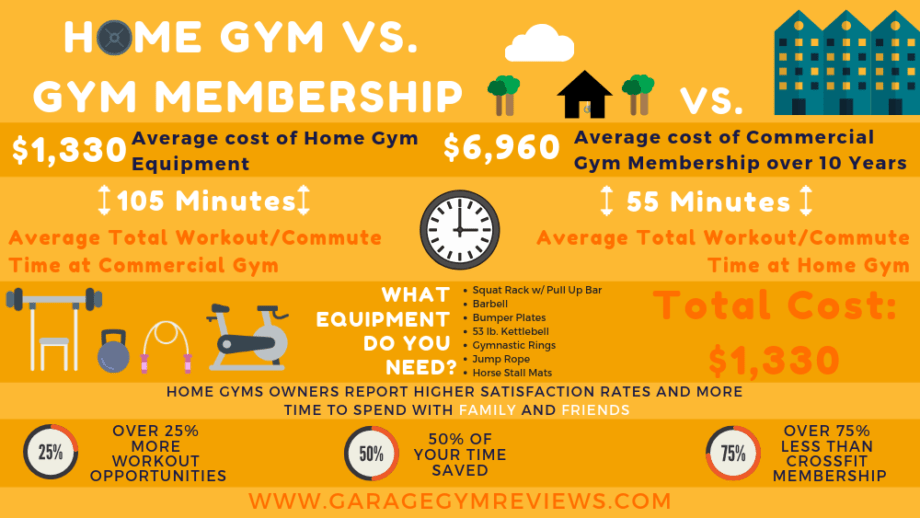
The cost of a home gym versus a membership at a commercial gym like a CrossFit Affiliate, Gold’s Gym or something similar is the main determinant for people considering home gym ownership. Sure, there are a ton of benefits to having a home gym, but I find that for most people, it simply comes down to cost.
“Can I build a home gym that allows me to accomplish my goals without ruining myself financially?”
I always find our purchasing decisions kind of funny. For instance, many of us are likely reading this on a phone that costs upwards of $1,000, not including our unlimited everything plans. Many also eat out for most meals and have a rather nice vehicle. It’s your money, so you should do as you please with it, however, if I were to ask you what the most important things to your were, your cell phone and car would likely not even make the list. It would be some variant of your family, friends, faith, and personal health.
I say this to illustrate the fact that it’s become acceptable to purchase a 4-figure phone that must be upgraded every few years (many upgrade every year…don’t worry, I do the same), but a purchase like a home gym that never has to be upgraded and can improve pretty much every area of your life is highly scrutinized. A home gym can literally be one of the best financial decisions you make as well, and here’s why:
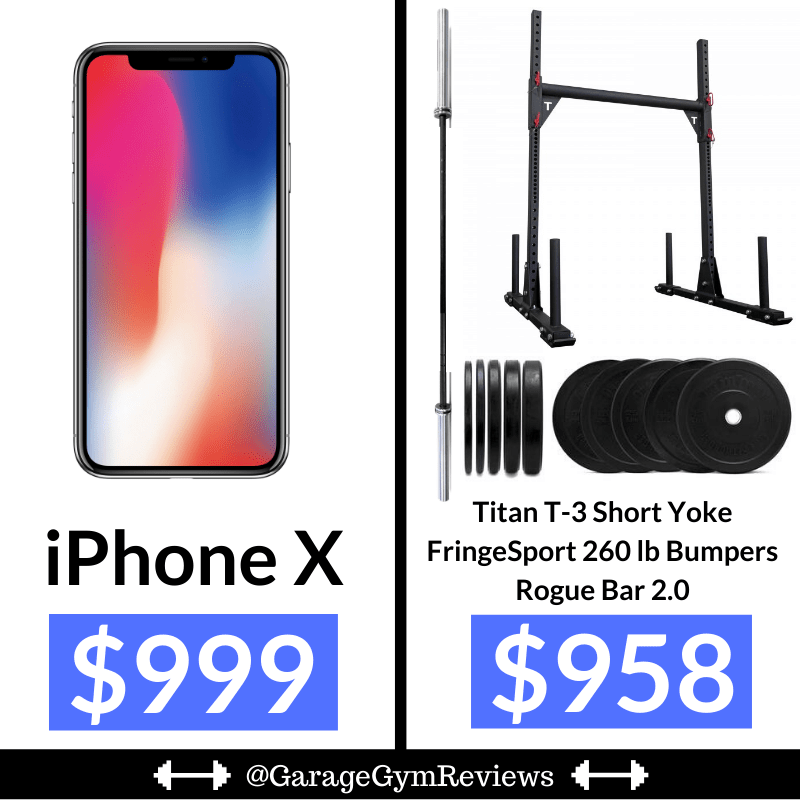
According to research done by the RunRepeat on Gym Membership Market Analysis done in 2021, the average gym membership in 2021 ranges from $31 to $44 a month, and in the US the average annual membership cost is $479. If you train at a CrossFit Affiliate, the average gym membership in the United States is $155 per month which comes out to $1,860 a year according to Rounds For Time!
Here’s an interesting tidbit on this though—these numbers don’t include annual fees, initiation fees, the cost of gas and car maintenance to get to and from the gym, or extra things purchased at the gym like supplements, apparel, etc (trust me, I own a gym so I know how often these things are purchased.)
So, if the cost of a commercial gym is currently around $479/year (this is also growing by ~3% per year due to inflation and other factors, FYI) which is $5,491/decade, then how does that compare to a home gym?
Well, let’s take a look.
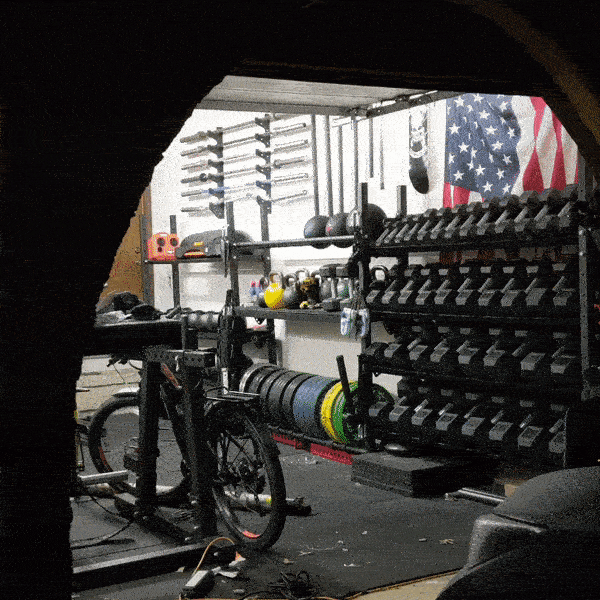
First off, unfortunately, we have no accurate market data on people who have built a gym in their home. I’d love to come up with a number and declare it as fact, but that would be disingenuous and I don’t want to lead anyone astray.
What I will say, however, is that based upon what I see through the people who send us their setups, ask for advice, and offer recommendations, the average cost for a home gym is between $1,000-$2,000 for most people. This number can be both less and much, much more, but this seems like what most people spend on their home gyms in the short term.
So, let’s compare these numbers to a gym membership. As we’ve established, a membership to a local gym costs an average of $44 a month into perpetuity. If the average home gym costs $1500, then it would take just short of three years to recoup the costs of a very well-equipped setup in comparison to the average gym membership. With the home gym, however, you have an asset that can be traded for other goods or money (and if you buy right, it will have outstanding resale value) and the only ongoing fee you have is the cost to keep the lights on in your garage or spare room.
If we’re looking just at financials, to me, the cost of a home gym is a much better decision than a gym membership.
What You Need to Build a Home Gym
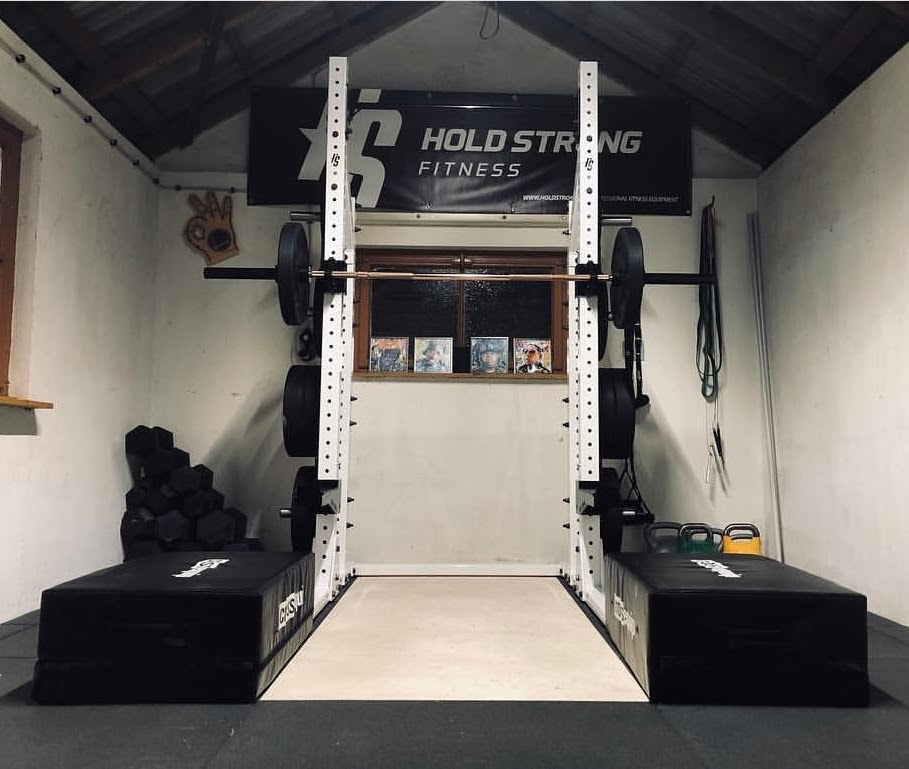
Now that I’ve at least drawn your interest in enough to have you consider a home gym, the next thing you need to determine is what equipment you should use to build your setup. Before I give some recommendations, I will say that everyone has different goals and objectives in terms of their mental and physical health, so the tools you choose should reflect those goals. However, there are a few movements that can benefit nearly EVERY human being, and thankfully, the equipment needed to accomplish those movements are readily available and not overly expensive.
For most people, the equipment we suggest starting out with are:
- An Olympic Barbell
- A Squat Rack with a Pull-Up Bar Attached
- Weight Plates
- A Weight Bench
- Exercise bikes
- Rowing Machine, Air Bike, Jump Rope, Sled, or some other cardio machines
(Alternatively, or in addition, you may consider an all-in-one home gym machine to serve multiple purposes.)
There are a myriad of other tools that can be added to this setup as well, such as adjustable dumbbells, kettlebells, a treadmill, lat pulldown, etc. Another “nice to have” that not a lot of future home gym owners consider is flooring. This will add to your overall cost depending on the material you choose, but can also be economical if you get creative—horse stall mats, for example. Having appropriate flooring may save your garage from damage. You can learn more about this in our guide on the best home gym flooring.
These are things we suggest adding over time as your needs and desires grow. The only economic reason to buy everything at once is to save on shipping. But, this is detrimental if you’ve never worked out at home and don’t know if:
A. You’ll like it
Or
B. You don’t know what you’ll ACTUALLY use
For these reasons and more, we suggest starting small and building over time to save money and avoid having things sit in the corner or trying to salvage some of your money on Craigslist. You can achieve just about any physical goal you have with these tools. Want to get stronger? Great, do higher weight and lower reps. Want to increase hypertrophy (bigger muscles)? Awesome, do more reps with more isolated movements. Want to lose fat and showcase your abs that have been hiding for years? Perfect, do more HIIT-type training with less rest (and work on your diet!)
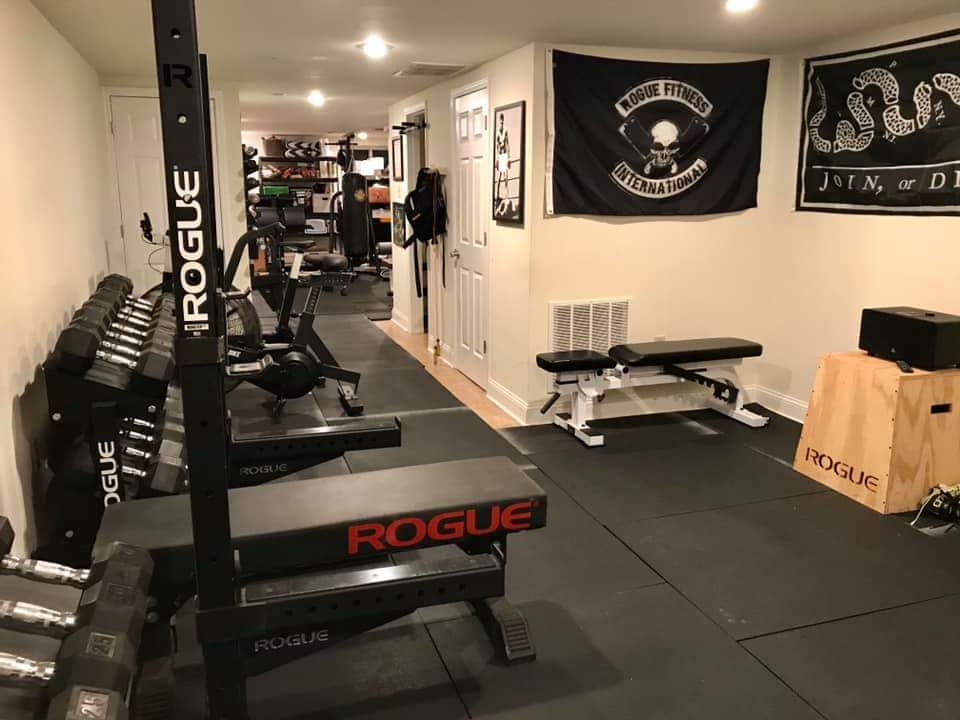
Nearly every home gym utilizes these items and just about any training program you plan to follow will use these for a majority of the workouts. Do not make the mistake of overbuying and underusing; you will be much better off buying less and upgrading over time.
With this said, I’d like to provide some suggested equipment at various price points for each of these categories:
The barbell will be one of your most-used pieces of equipment in the gym (probably right behind the squat rack.) When you begin researching barbells, you start to notice the wide variety of both options and prices that are available. You can get a barbell for anywhere from $100 to $1,500 or more. We don’t want to bore you with all of the details to look for in buying a bar (we’ve already done that here), so we’re just going to list a few different options that are the favorites of ours and our readers.
RELATED: Best Barbell Exercises
Versatile Pick
Rogue Bar 2.0
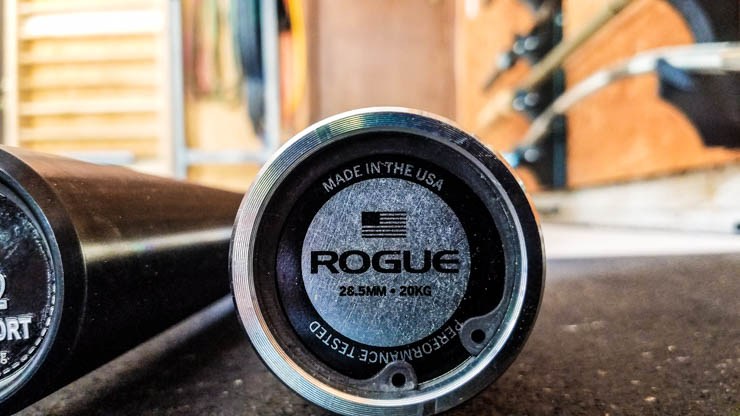
Product Highlights
- Barbell made in the USA
- 190K PSI tensile strength
- Multiple composite bushings
- 28.5 mm shaft diameter
- Dual knurl marks for Olympic lifts or powerlifting
- Lifetime warranty
Pros & Cons
Pros
- 190K PSI tensile strength
- Made in the USA
- Multiple composite bushings
- Good value
- 28.5 mm diameter with dual knurl marks for versatility
- Lifetime warranty
Cons
- Black zinc coating can fade over time
- Passive knurling
Bottom Line
The Rogue 2.0 Bar is a good barbell with great value. With a good tensile strength and versatile use, this is a great multipurpose bar for the home gym.
The Rogue Bar 2.0 won our Best Olympic Barbell title recently, and for good reason. The Rogue Bar 2.0 is one of the most popular barbells in the world. It combines Rogue Fitness’ attention to detail, outstanding customer service, and their large manufacturing power to create a bar that can handle any training style, any weight, for as long as you care to use it. Throw a lifetime warranty and a sub-$300 price tag and you have one incredible bar.
Best Power Bar
Rogue Ohio Power Bar
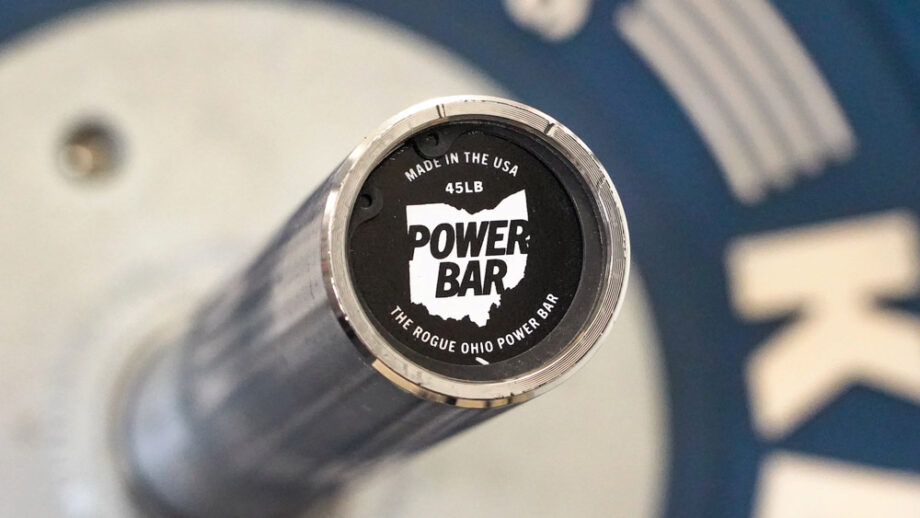
Product Highlights
- Volcano knurl provides a great grip
- IPF-approved
- Lifetime warranty
- Four coating options: bare steel, black zinc, Cerakote, and stainless steel
- 205K PSI tensile strength
Pros & Cons
Pros
- Great value
- Volcano knurl
- Fantastic grip
- IPF-approved
- Lifetime warranty
- Four coating options: bare steel, black zinc, Cerakote, and stainless steel
- Made in the USA
- 205K PSI tensile strength
- F-8R rating
- Self-oiling bronze bushings
Cons
- 205K PSI tensile strength is not the strongest on the market
- Some may feel the knurling is too passive
- Bare steel Version rusts quickly
Bottom Line
The Rogue Ohio Power Bar is the power bar we recommend most often. You cannot spend less and get a better bar. You can spend more, and depending on your preferences get something maybe better, but even then, it's debatable.
If you plan to mainly stick to the big-4 — the squat, deadlift, bench press, and overhead press, then we suggest going with a power bar. Power bars, unlike the Rogue Bar 2.0 previously mentioned have a bit thicker diameter shaft, a more aggressive knurl, and a center knurl to help stick to your shirt when squatting. The Rogue Ohio Power Bar has been the go-to power bar for most people for some time.
Rogue has used the same qualities that make the Rogue Bar 2.0 such a popular pick, but thickened the shaft diameter, made the knurl more aggressive, and used stronger steel. Whether you squat 135 LB or 700 LB, this bar will do the job and do it well.
Rep Fitness
REP Fitness Colorado Bar, 20 Kg
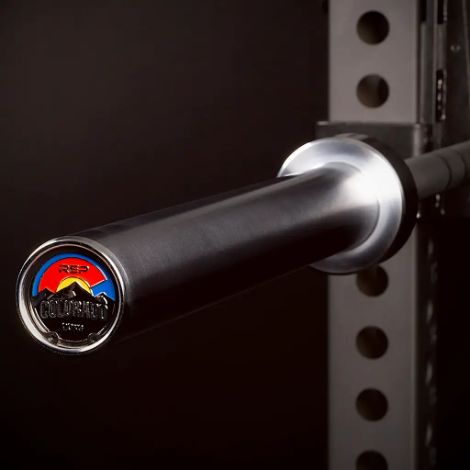
Product Highlights
- 20-kg Olympic barbell for mixed use
- Hard chrome or cerakote coating with Duracoat sleeves
- 28.5 mm shaft diameter
- Dual knurl markings for IPF and IWF
- 190 KSI tensile strength
- Composite bushing
Pros & Cons
Pros
- Durable composite bushings reduce noise when dropping
- Medium volcano knurling
- Dual knurl markings for IPF and IWF
- Designed for versatile use
- Free shipping
- Different color options
- 28.5 mm shaft provides great grip
Cons
- No center knurling, which may be important for some
- Shaft diameter not to IWF specs
Bottom Line
The 20-kilogram Colorado Bar from REP Fitness is a durable, versatile Olympic barbell made for heavy powerlifting, Olympic weightlifting, and cycling weights in CrossFit workouts. The barbell has two knurl markings for IWF and IPF specs. The bar is available with a hard chrome finish or different-colored cerakote finishes with Duracoat on the sleeves. With composite bushings, the barbell provides decent spin and durability that helps dampen noise when dropping weights.
If you’re looking for another multipurpose barbell that we’d recommend, then the REP Fitness Colorado Bar is a good option, for about $320 with free shipping. With the choice of either a chrome or more expensive cerakote shaft finish, it’s a durable bar with a high tensile strength. It performs well through different types of training, whether it be Olympic lifting, powerlifting, or CrossFit, and should hold up to most workouts.
Now that you have a bar, you need a squat rack. The squat rack will be the centerpiece of your gym and if you’re like most garage gym owners, it will be the most used piece of equipment you have. Due to the amount it’s used, and the fact that it’s largely designed to help save your life should you fail a lift, your goal shouldn’t be to just buy the cheapest rack possible. However, thanks to the growth in home gyms, there are now more racks available than ever before and even better than that, they’re lower in price than at any time in history.
Versatile Rack Pick
Rogue RML-390F Flat Foot Monster Lite Rack
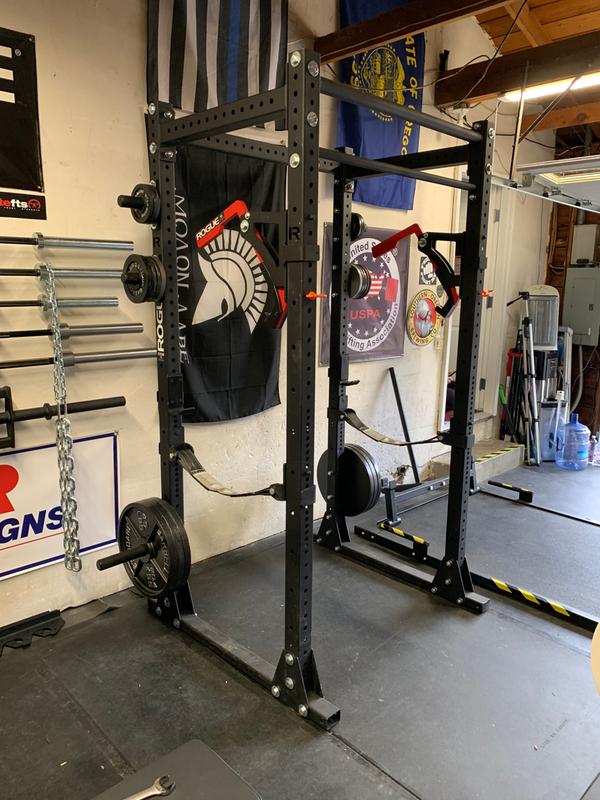
Product Highlights
- Made in the USA
- Self-stabilizing base (no need for bolting)
- Compact, 48-inch base size
- Monster Lite J-Cups and pin pipe safeties included
- Pull-up bar included
Pros & Cons
Pros
- The Rogue RML-390F Flat Foot Monster Lite Rack is one of the only flat footed power racks that Rogue sells (which probably explains why it's so popular.)
- Although we have heard of Rogue screening their review sections, the RML-390F currently has over 140 reviews with a 5/5 star rating making it one of the most reviewed racks on Rogues site.
- As with all racks in the Monster Lite line, this one uses 3"x3" 11-guage steel and â…" holes that allow it to be compatible with the entire line of Monster Lite Attachments such as pull-up bars, lever arms, and spotter safeties.
- Due to the flat foot design, the rack doesn't have to be bolted to the ground to be used.
- Because the rack is spaced 48" deep, you shouldn't have to worry about the rack falling over due to a lot of weight on the barbell for squats or bench press.
- Pin Pipe Safeties are included with the rack, but they can be upgraded to straps (which we most often recommend to protect the knurling on your barbell.)
- The entire rack is made in the USA with US-sourced steel, including the bolts.
- Westside Hole Spacing is included through the bench area which means you can dial in your j-cups in 1" increments to get the perfect setup.
- You can't use band pegs or half spotter safety arms on the rack because it's bolted down and could topple over if not careful.
- A pull-up bar with Rogues signature textured powder coat is included, but can be upgraded if desired.
Cons
- The RML-390F only comes in one height, 90", which may be too tall for basement home gyms or not tall enough for certain trainees.
- The rack is definitely less stable than one bolted down, but for most home gym owners, it should be fine.
Bottom Line
The Rogue RML-390F Flat Foot Monster Lite Rack is a great squat rack option for home gym owners that don't want to bolt their rack to the ground. In our review, we've found that the rack is pretty stable due to its weight (even more stable if weight plates are added to plate posts) and it checks all the boxes for a typical overbuilt Rogue rack. This is honestly Rogue's best option for someone who doesn't want to bolt their rack to the ground and doesn't want a 6 post rack like a Rogue RM-6. However, understand that because it's made in the USA, it is pricier than some of the competition that is imported like Titan Fitness or Rep Fitness.
The Rogue RML-390F is a rack we often suggest and for good reason. It’s a flat foot rack, meaning it doesn’t have to be bolted down to the floor and therefore can perform equally well in a garage and bedroom. It’s made of heavy-duty 11-gauge steel, 3”x3” uprights and has a ton of available accessories. For most people, this is a great option (it also currently has a rating of 5.0 with 120+ reviews.)
If you’re set on Rogue and just want the biggest, baddest rack you can buy, check out their Rogue Monster 2.0 Series. The RM-6 is one of the beefiest racks you can buy and if you can afford it, you’ll be happy you went that way.
Ultra Budget Rack
REP PR-1100 Home Gym Power Rack
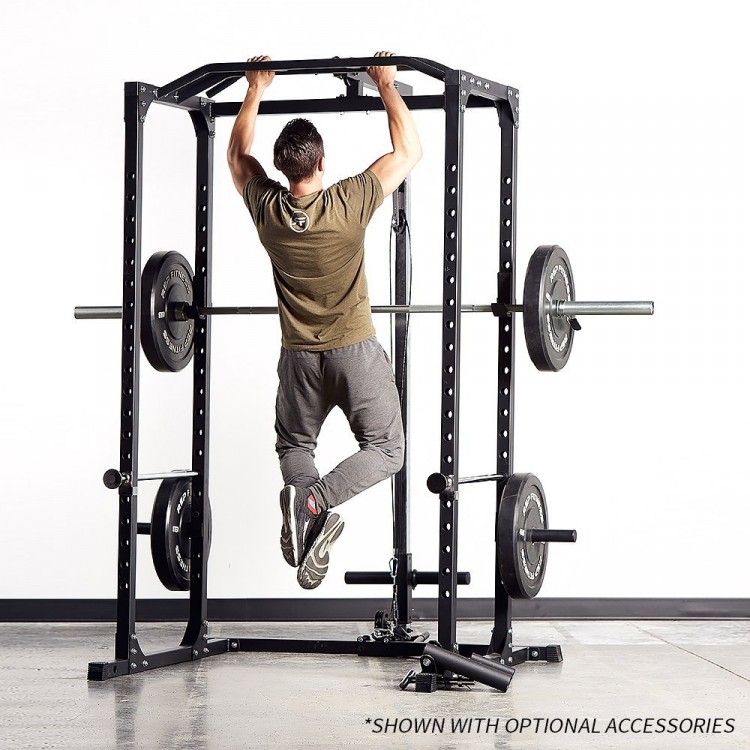
Product Highlights
- Rated at 700 lbs
- Designed for home and garage gym owners
- Has professional features
- Compact and versatile
- Multi-grip pull-up arch
Pros & Cons
Pros
- Good balance between value and versatility
- Shown to exceed durability and weight capacity expectations
- Budget-friendly
- Has different color options
- Multi-grip pull-up bar
- Flat-footed rack base
- Laser-cut numbers every five holes on uprights
- Plastic-lined J-cups
- Included chrome-plated safeties
- Ability to add attachments
Cons
- Competitors at this price range or less
- Assembly can take some time as it is largely bolted together
- 14-gauge steel
- 700-lb weight capacity
Bottom Line
The REP Fitness PR-1100 is, in our opinion, one of the best value squat racks on the market for those just starting a home gym or squat/bench less than 700 LB. In our review, we've found that this is a stable power rack with many features taken from racks twice its price. This includes upright color options, a multi-grip pull-up bar, UHMW j-cups, and numbered uprights. If you're trying to build a budget home gym, this is an excellent option, just be aware that you may want to upgrade in the future.
If you’re on a tighter budget than what the RML-390F from Rogue Fitness allows, then we recommend the REP PR-1100 Home Gym Power Rack. It’s available with a myriad of features, is sturdy enough for most people, and best of all, is quite affordable at under $300 shipped. We’re big fans of this rack for beginners or just those wanting to save some cash.
Weight plates will be used mostly on the sleeves of your barbell, but they can also be used for other movements as well. They can easily be attached to a belt for weighted pull-ups or dips, held in your hands for Russian twists, or even used for farmers walks to increase your grip strength. We most often suggest searching out used sources for weight plates as they can get expensive quick. Both Craigslist and Facebook Marketplace are great places to search for both used iron and bumper plates. If you plan to drop the bar from overhead after cleans and snatches, then get bumper plates. If not, you’ll be fine with cast iron and your wallet will thank you.
Budget Bumper Plates
Fringe Sport Black Bumper Plates
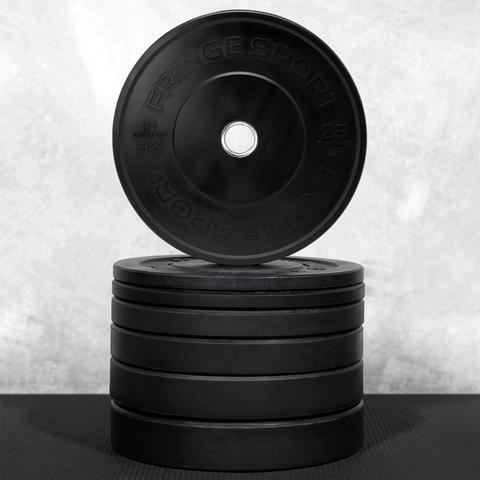
Product Highlights
- Use 100% virgin rubber
- Shore Durometer of 85 sHA for a dead bounce
- Strong 10-lb that withstand dropping plates
- Free shipping
- Weight tolerance is +/- 1% of stated weight
Pros & Cons
Pros
- Use 100% virgin rubber
- Shore Durometer of 85 sHA for a dead bounce
- Have a 55-lb option
- Beveled edge that makes them easier to carry
- Unique hooked insert so more surface area of the insert grabs onto the rubber
- Free shipping
- Claims it’s okay to drop the 10-lb plates
- 3-Year Warranty comes standard
- Weight tolerance is +/- 1% of stated weight
Cons
- Wide plates
- Can’t load more than 500 lbs on most bars
Bottom Line
The Fringe Sport Black Bumper Plates are generally the best value bumper plates that we've reviewed. They feature a good warranty, have a wide variety of weight increments, low bounce, and are extremely durable. If you're looking for bumper plates for Olympic Weightlifting or CrossFit and want something that will last without (totally) breaking the bank, then these are a great option.
Many home gym owners, due to the desire to reduce noise and prevent damage to their foundation, prefer rubber bumper plates over iron. If you’re looking for bumper plates, Fringe Sport Black Bumper Plates are both a high-quality and affordable option. We suggest sticking with just the amount of bumper plates you’d like to use for the Olympic Lifts, and going with iron plates for the rest. So pick up a couple 45’s, 25’s, and 10’s and you should be set.
If you want a competition bumper plate, the Rogue Competition Bumper Plate is one of the most popular, but expect to pay a pretty penny.
Iron Plates
Rogue Machined Olympic Plates
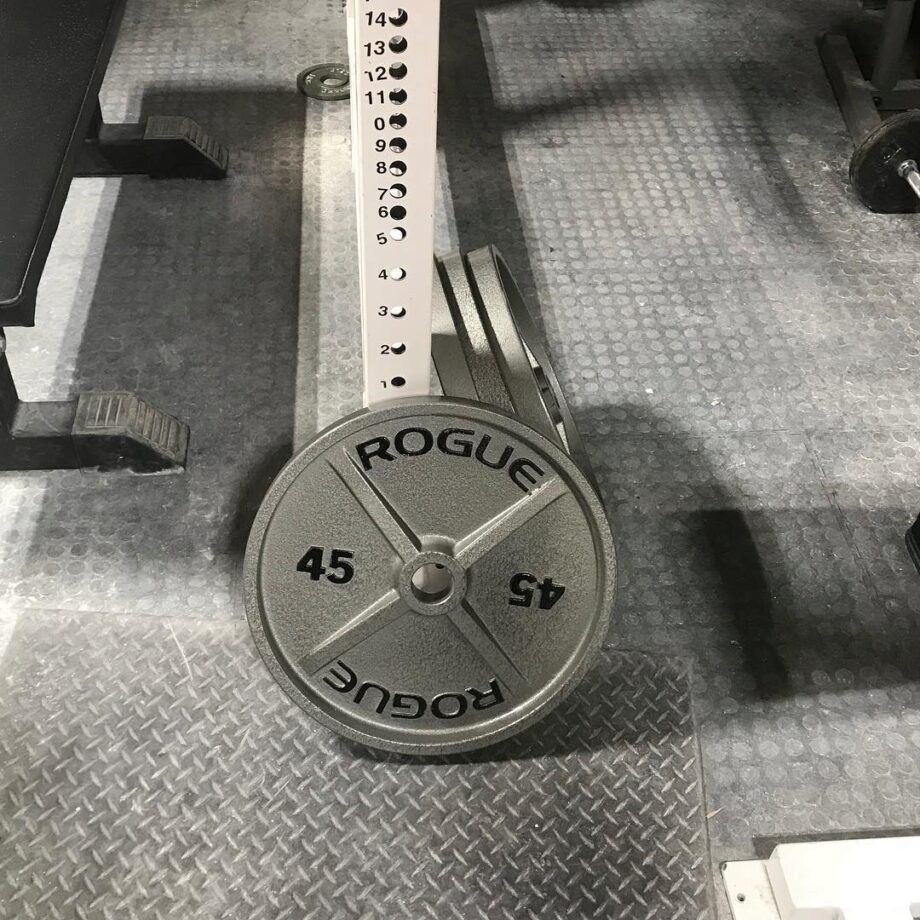
Product Highlights
- Cast-iron plates sold in pairs or as a 245-lb set
- Hammerstone finish with black text
- Range from 2.5 lbs to 45 lbs
Pros & Cons
Pros
- Precision machined
- Unique finish
- Good value
Cons
- Not meant for dropping
- Customers sometimes report cosmetic issues
Bottom Line
If you're looking for a solid set of iron weight plates, Rogue Machined Olympic Plates are a solid choice. These cast-iron plates are made with precise tolerances only to be heavier, not lighter, than the reported weight. If the weight is lighter, Rogue will replace the plate.
If you want steel plates and don’t want to take our advice of buying used, then the Rogue Machined Olympic Plates are a great option that is very consistent and accurate. Iron plates will often range in weight from 5-10% off the stated weight which is far from ideal. The Machined Olympic Plates from Rogue Fitness are guaranteed to be within +2%/-0% of the stated weight. Meaning they’ll only be more, never less and if they are, Rogue will trade them out.
Budget Iron Plates
REP Iron Plates
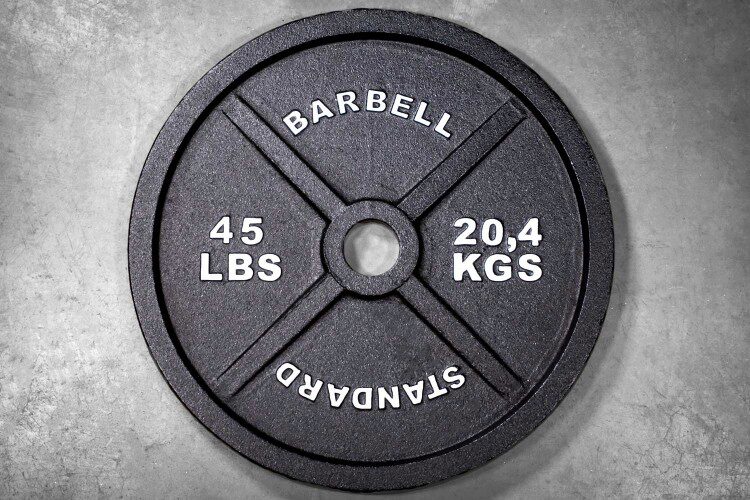
Product Highlights
- Well-priced plates with solid construction
- Fit Olympic barbells
- Sold in pairs or sets
Pros & Cons
Pros
- Fit most Olympic barbells
- Are sold in pairs
- Raised lips make them easy to pick up
- Great price
Cons
- Frequently sold out
- Not meant for dropping
Bottom Line
These are great iron plates at a good price for most home gym owners.
The cheapest iron plates we suggest are the REP Iron Plates. These plates aren’t exactly pretty, but they weigh very close to their suggested weight and are priced extremely well compared to the competition. If you just want to get something that works and don’t want to buy used, these are likely your best bet.
The next piece of equipment we suggest getting is some sort of bench. A bench, whether flat or adjustable will allow you to bench press, but also do much more than that. A bench can be utilized for various pulling movements, step ups, box jumps, box squats, split lunges, and much more.
Top Pick
REP FB-5000 Competition Flat Bench
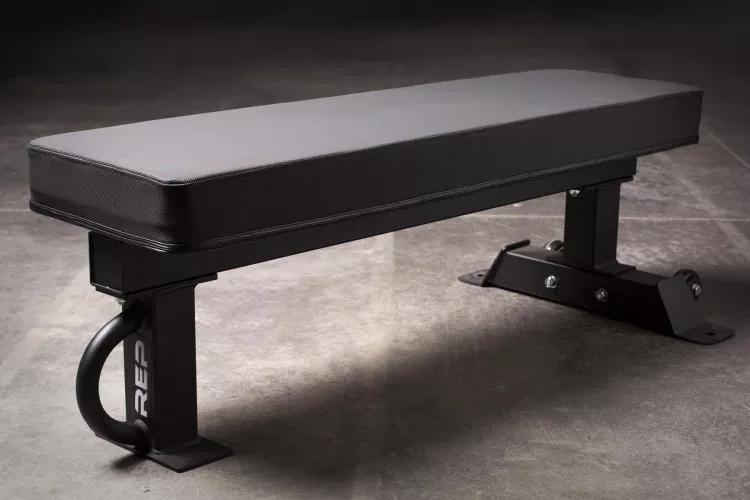
Product Highlights
- Great price on a high-quality bench
- Compatible with REP Wide Pad or Thompson Fat Pad
- 3″ x 3″ 11-gauge steel provides solid construction
Pros & Cons
Pros
- Great price for a good value bench
- 3” x 3” 11-gauge steel
- Sturdy 3-post bench
- Nothing in the way of your feet when you bench
- Rated to 1,000 pounds
- Meets the IPF specs for length, height, and width
- Comes with a 4” thick pad on a plywood base with durable vinyl upholstery and the option to purchase an extra wide pad
- Comes with a handle and wheels
- Compatibility with 2 other bench pads including the extra wide and the Thompson Fat Pad
- Easily assembled in less than 20 minutes.
- Available in multiple colors and designs.
Cons
- Shipping not included in price
- Short manufacturer’s warranty
- Some assembly required
- 30-day return period and restocking fee applied to returns
Bottom Line
The Rep FB-5000 Flat Bench is the best value flat bench we've tested and reviewed. It offers an incredible combination of price and quality that many companies have overlooked for some time. With over 250 customer reviews, there is not 1 under 4 stars and most of those are for less than minor complaints. If you need a flat bench, this is the one we suggest. You could pay more, but it would still probably not be as good. Seriously.
REP Fitness is making some of the best value benches. The REP FB-5000 Comp Flat Bench is one of our favorite flat benches at just about any price point, and it’s thankfully very affordable at less than $200 shipped. It’s sturdy, easy to maneuver, sits at a proper height off the ground and just works.
If you’re looking for an adjustable bench, then we suggest looking at the REP AB-5100 Adjustable Bench. It’s very sturdy, has a wide variety of incline options, has the option of attaching feet holds for decline sit-ups and bench and is priced well compared to the competition.
Ultra Budget Bench
AmazonBasics Flat Weight Bench
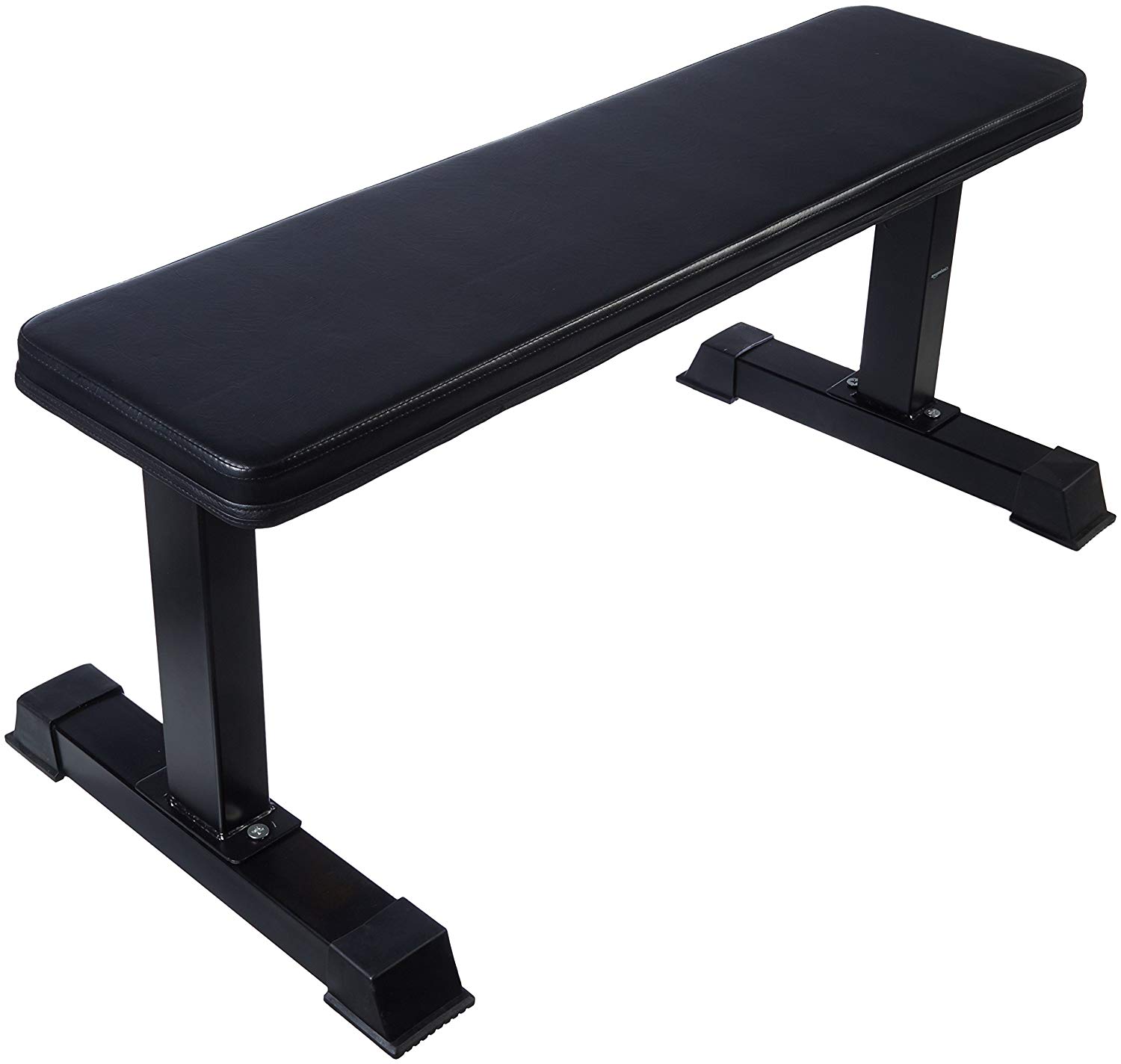
Product Highlights
- Priced under $50 shipped free with Prime
- 17.1″ height makes it right around IPF Powerlifting Standards
- Tested with heavy weight with no issues
Pros & Cons
Pros
- At under $50 shipped most often, the AmazonBasics Flat Weight Bench is one of the cheapest benches available.
- There's nothing flashy about it, it just works.
- 17.1" height makes it right around IPF Powerlifting Standards.
- Although the weight limit is low, we tested it for much more than what they suggest without any issues.
Cons
- Low suggested weight limit.
- Weak gauge steel.
- Short warranty.
Bottom Line
The AmazonBasics Flat Weight Bench is an extremely cheap bench that does what it's supposed to do. In our review, we found it to hold more weight than expected, be more sturdy than expected, and just overall well worth the price. If you want a cheap weight bench that just works (and don't mind the low weight limit) this is your best bet.
If you just want something to get the job done, then the AmazonBasics Bench at under $50 is a steal. It’s not the best bench we’ve ever used, but it held up much better than we expected and it’s hard to make any complaints considering the price point. One suggestion we’d make though is seeing if there are any benches in the Amazon Warehouse as we’ve occasionally seen them in there for less.
We do not recommend buying an extremely cheap adjustable bench. You’ll find them very to be unstable, awkward, and easily breakable.
The last thing we suggest, and this is really more of an optional piece of equipment, and that is cardio equipment. Conditioning can easily be done without equipment and is often best done that way, in the sun and fresh air. Sprints, runs, bear crawls, bounding leaps, handstand walks, and more can be done without any additional equipment and can get you in excellent condition.
Versatile Sled
Rogue Slice Sled
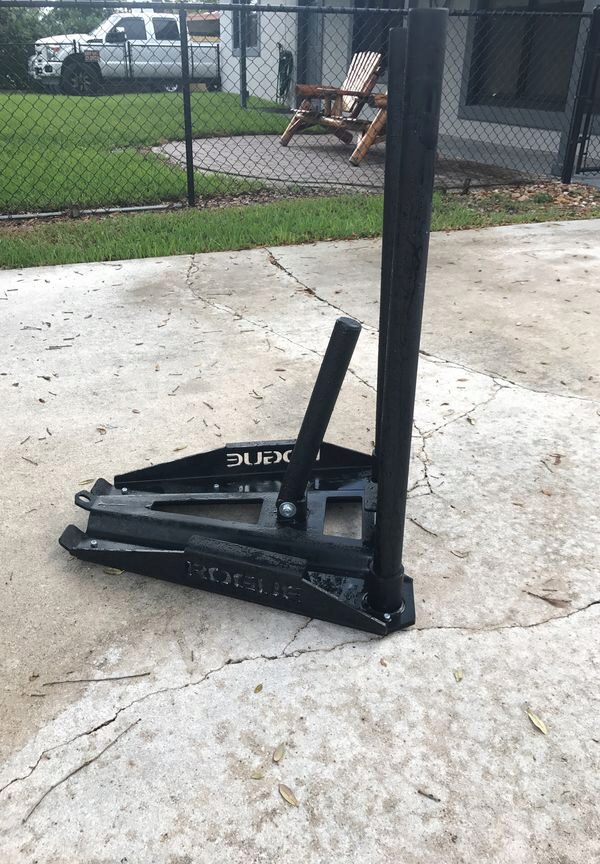
Product Highlights
- Push/pull weight sled
- Fold-flat, stackable storage
- 14″ bolt-on center post
- Load capacity of well over 300 lbs
Pros & Cons
Pros
- Push/pull weight sled
- Quality steel construction
- Fold-flat, stackable storage
- Comes standard with two 40" upright push handles
- Laser-cut hole, sled strap, and carabiner also included
- Weighs 65 lbs unloaded
- 14" bolt-on center post
- Load capacity of well over 300 lbs
Cons
- Handles might be too short for some
- Shipping cost not included in price
Bottom Line
Whether you want to do sled drags, rope pulls, or traditional prowler sprints, these can all be accomplished with the Slice Sled despite its compact form.
For most people, a simple jump rope would do the trick. A sled would work extremely well as well. For sleds, we really like the Rogue Slice Sled as it can be dragged or pushed and is priced pretty well. If you’ve never done sled walks, then you and your hamstrings are in for a treat.
RELATED: Best Jump Rope
If you’d like to get something more robust, then we suggest looking at a rower and more specifically, the Concept 2 Model D Rower. It’s one of the most well-liked pieces of cardio equipment and will outlast you. We did a full breakdown of nearly every rowing machine available and the Concept 2 Model D Rower was still our top pick despite the amount of newer competitors.
Air Bike
Rogue Echo Bike
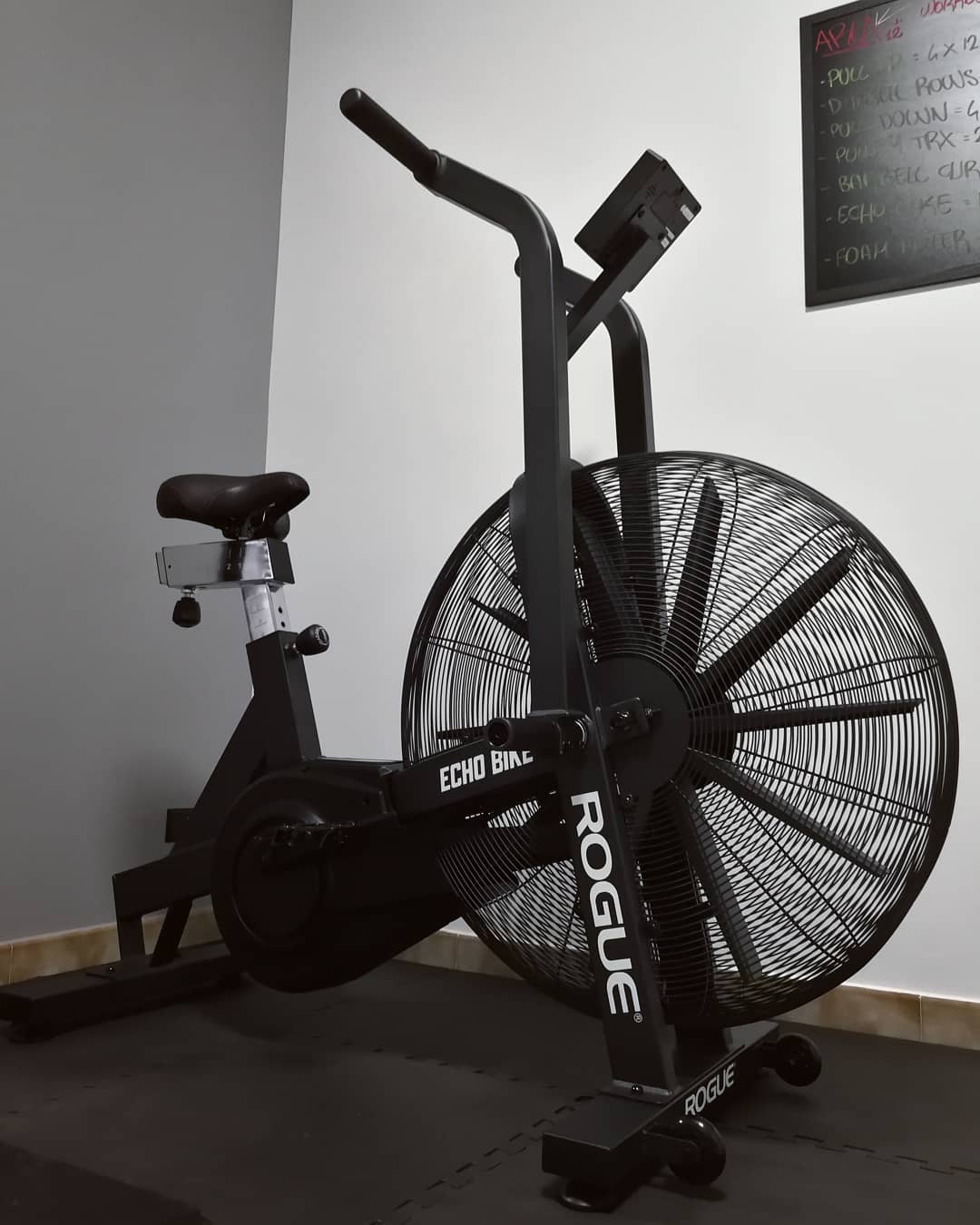
Product Highlights
- Heavy duty steel
- Overbuilt for smooth ride
- 350 lb weight limit
- Solid foundation for max outs
- Easily portable
Pros & Cons
Pros
- Extremely durable, beefy construction
- Very little rocking or side-to-side movement
- Black powder-coated metal on almost everything
- Belt-driven fan for much less maintenance.
- Easy-to-read LCD console screen
- Legs feature adjustable leveling feet
- Somewhat compact
- Oversized, heavy-duty front wheels
- Sleek, attractive look
Cons
- Larger than other stationary bikes
- Belt drive is overall harder to push than a chain drive
- Not the cheapest air bike on the market
Bottom Line
We’ve tested just about every air bike on the market, and the Echo combines many of our favorite features into one. The belt drive is much more durable and requires less maintenance than a chain drive. The size and weight make it extremely stable, and the price is much less than we’d expect for such a quality piece of equipment.
If you want an air bike, then we suggest the Rogue Echo Bike, you can see the full review we did on it here and the breakdown of the Best Air Bike here.
Where You Should Buy Home Gym Equipment
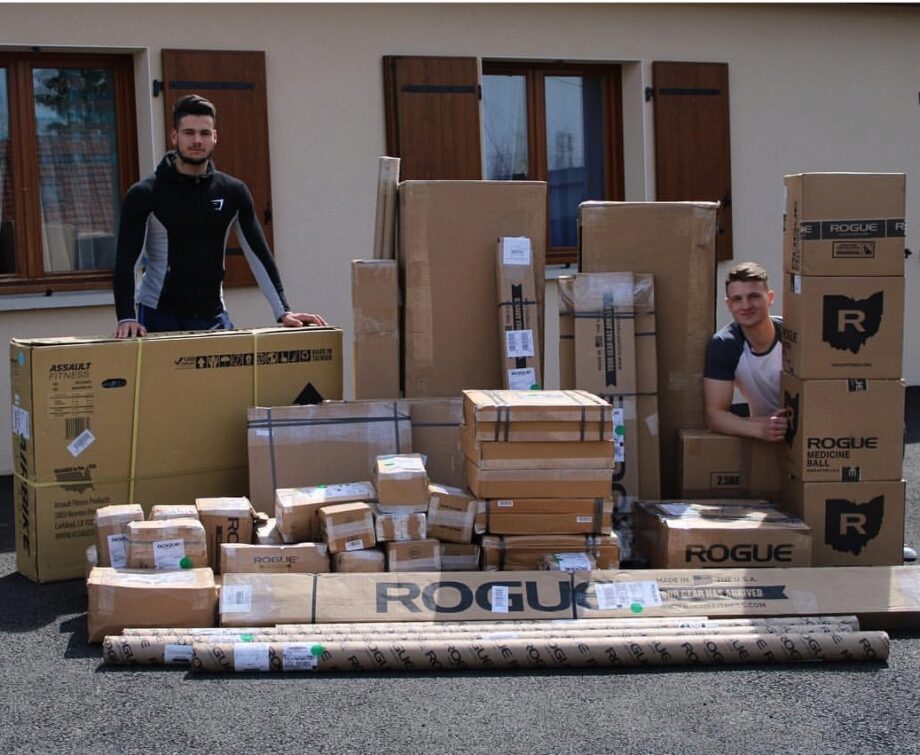
Due to the explosive growth of people working out at home, there are now more places to purchase equipment than ever before. Although it’s great to have so many options, not every company is worth your time and money.
Here are a few we’d suggest:
Rogue is largely considered the premier gym equipment maker in the US. They definitely have competition, but it’s hard to argue with their price to quality ratio. Not only are they making great equipment, but they spend a lot of their time focusing on helping people set up home gyms.
REP Fitness is making a lot of great equipment for the home gym crowd and although most of their equipment isn’t to the level of Rogue, it is often much cheaper. We suggest REP Fitness often.
Fringe Sport is making some outstanding equipment, and again, are focusing on the home gym market. Based out of Austin, Texas, Fringe Sport imports most of their equipment, similar to REP Fitness, but puts their own unique spin on a lot of items.
If you’re looking for equipment that is space saving (most home gym owners are) then we suggest taking a lot at some of PRx Performance’s fold-away racks. They’re built extremely well and use an amazing amount of ingenuity. They have some additional fold away pieces as well.
Amazon is the world’s largest e-commerce store and this power extends to home gym equipment. Although they don’t have a lot of higher-end equipment, they do have a large variety of budget-priced pieces so they’re always worth looking at.
So, How Much Does a Home Gym Cost?
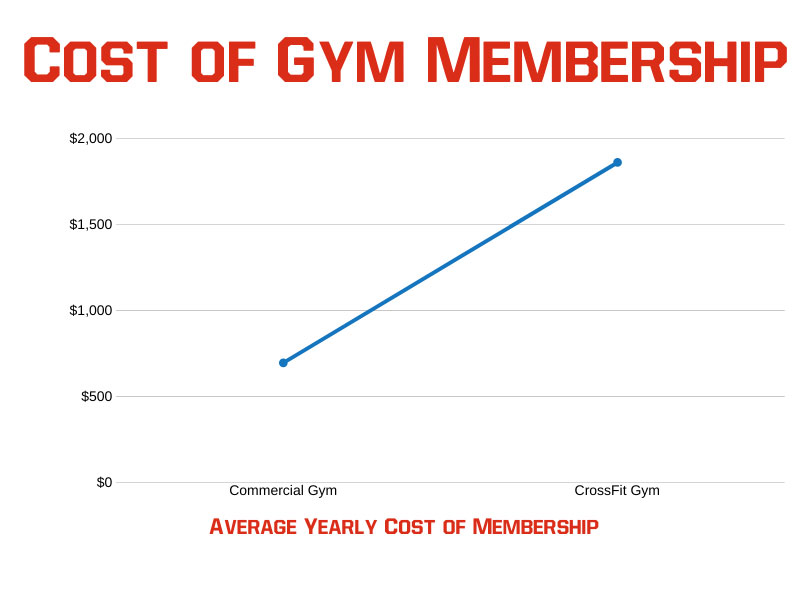
As you can see, a home gym can vary widely. We see the average cost for most home gym’s around $1,000 to $2,000, but you can get one for less or much, much more. We suggest budgeting a couple thousand dollars, buying the equipment you need to get started and build your gym out further over time.
I do want to say this though, regardless of whether you choose a home gym or a commercial gym (you should choose a home gym) you need someplace to workout. Healthcare costs continue to grow at an exponential rate and we at Garage Gym Built just want to see people get healthier. So, join us in the fight against obesity and complacency. Build a home gym and reach your goals!
How Much Does a Home Gym Cost? FAQs
How much should I spend on a home gym?
This is honestly up to you. We suggest starting small and growing over time, but if you know you’re going to use the equipment, it can save you shipping costs by making one large order versus small orders.
When is the best time to buy gym equipment?
If you’re wanting to order from Rogue, we’ve detailed how to save money on Rogue Fitness equipment here. For everyone else, Black Friday typically offers the best discounts.
Should I buy the cheapest equipment I can find?
This depends on the various pieces of equipment. We suggest spending the most on your barbell and squat rack, other times are typically less important to have high quality (it does depend on the piece, however.)
Check out my recommendations for the best budget home gym equipment if you’re working on a lower budget.
Further reading

Looking for the best Fuel Meals coupon? Our Fuel Meals Discount Code page explains how to use our exclusive code to get 50% off your first order. Read more

So you want to build a gym at home, and you’re wondering, “How much does a home gym cost?”. You’re not alone; this is by far one of the most asked questions we receive. We’ve detailed just how much you can expect to spend and believe it’s likely much less than you think. A home gym can not only be built on a budget, but it can also be an extremely smart financial decision. » Read more about: How Much Does a Home Gym Actually Cost in 2025 » Read more

What is a sauna suit? Get all of the sweaty details to when, why, and how you might want to suit up here. Read more

Mat Fraser is the World's Fittest Man. He also has one sweet home gym setup in the basement of his parent's house. For the size, it's EPIC! Read more

